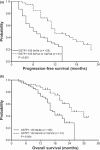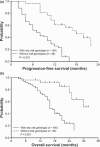Influence of GSTP1 I105V polymorphism on cumulative neuropathy and outcome of FOLFOX-4 treatment in Asian patients with colorectal carcinoma
- PMID: 19922504
- PMCID: PMC11158438
- DOI: 10.1111/j.1349-7006.2009.01418.x
Influence of GSTP1 I105V polymorphism on cumulative neuropathy and outcome of FOLFOX-4 treatment in Asian patients with colorectal carcinoma
Abstract
Glutathione S-transferase P1 (GSTP1) participates in detoxification of potentially genotoxic compounds that may alter the efficacy and toxicity of platinum-based chemotherapy. We analyzed the influence of I105V polymorphism of GSTP1 on clinico-pathological features and outcomes in 166 Chinese patients with metastatic colorectal carcinoma who had been treated with first-line FOLFOX-4. Combined analysis of GSTP1 I105V, ERCC1-118, and XPD-751 polymorphisms was also conducted. The results showed that, in comparison with Caucasian populations, a remarkably lower prevalence of Val105 allele variants was noted (24.7%). Patients with Val105 allele variants had a higher response to FOLFOX-4 (56.1%vs 37.6%, P = 0.04), and a longer progression-free (P < 0.01) as well as overall (P < 0.01) survival. By adjusted analysis, this polymorphism was identified as an independent prognostic factor (P = 0.01). In combined analysis, patients without any risk genotype, including GSTP1-105 Ile/Ile, ERCC1-118 C/T or T/T, and XPD-751 Lys/Gln, had significantly longer progression-free and overall survivals (P < 0.01). In addition, patients with Val105 allele variants had a higher incidence of grade 3/4 cumulative neuropathy after different cycles of treatment. These data suggest that Asian populations have a lower prevalence of I105V polymorphism in GSTP1. I105V polymorphism in GSTP1, by reducing its enzymatic activity and consequential detoxification to oxaliplatin, could be a key determinant for a better outcome, but more neurotoxicity, to FOLFOX-4 treatment.
Figures



Similar articles
-
Very low prevalence of XPD K751Q polymorphism and its association with XPD expression and outcomes of FOLFOX-4 treatment in Asian patients with colorectal carcinoma.Cancer Sci. 2009 Jul;100(7):1261-6. doi: 10.1111/j.1349-7006.2009.01186.x. Epub 2009 May 4. Cancer Sci. 2009. PMID: 19432884 Free PMC article.
-
Glutathione-S-transferase pi (GSTP1) codon 105 polymorphism is not associated with oxaliplatin efficacy or toxicity in advanced colorectal cancer patients.Eur J Cancer. 2009 Mar;45(4):572-8. doi: 10.1016/j.ejca.2008.10.015. Epub 2008 Dec 10. Eur J Cancer. 2009. PMID: 19084393 Clinical Trial.
-
Associations between oxaliplatin-induced peripheral neuropathy and polymorphisms of the ERCC1 and GSTP1 genes.Int J Clin Pharmacol Ther. 2010 Nov;48(11):729-34. doi: 10.5414/cpp48729. Int J Clin Pharmacol Ther. 2010. PMID: 20979931
-
Clinical management of oxaliplatin-associated neurotoxicity.Clin Colorectal Cancer. 2005 Apr;5 Suppl 1:S38-46. doi: 10.3816/ccc.2005.s.006. Clin Colorectal Cancer. 2005. PMID: 15871765 Review.
-
XRCC1 and GSTP1 polymorphisms and prognosis of oxaliplatin-based chemotherapy in colorectal cancer: a meta-analysis.Cancer Chemother Pharmacol. 2013 Mar;71(3):733-40. doi: 10.1007/s00280-012-2067-8. Epub 2013 Jan 9. Cancer Chemother Pharmacol. 2013. PMID: 23299794 Review.
Cited by
-
Oxaliplatin-Induced Neuropathy: Genetic and Epigenetic Profile to Better Understand How to Ameliorate This Side Effect.Front Mol Biosci. 2021 May 7;8:643824. doi: 10.3389/fmolb.2021.643824. eCollection 2021. Front Mol Biosci. 2021. PMID: 34026827 Free PMC article. Review.
-
Informative gene network for chemotherapy-induced peripheral neuropathy.BioData Min. 2015 Aug 12;8:24. doi: 10.1186/s13040-015-0058-0. eCollection 2015. BioData Min. 2015. PMID: 26269716 Free PMC article.
-
A phase II clinical study of mFOLFOX6 plus bevacizumab as first-line therapy for Japanese advanced/recurrent colorectal cancer patients.Jpn J Clin Oncol. 2013 Nov;43(11):1080-6. doi: 10.1093/jjco/hyt127. Epub 2013 Sep 1. Jpn J Clin Oncol. 2013. PMID: 23999770 Free PMC article. Clinical Trial.
-
Association between the ERCC1 rs11615 polymorphism and clinical outcomes of oxaliplatin-based chemotherapies in gastrointestinal cancer: a meta-analysis.Onco Targets Ther. 2015 Mar 16;8:641-8. doi: 10.2147/OTT.S80913. eCollection 2015. Onco Targets Ther. 2015. PMID: 25834456 Free PMC article.
-
A prospective validation pharmacogenomic study in the adjuvant setting of colorectal cancer patients treated with the 5-fluorouracil/leucovorin/oxaliplatin (FOLFOX4) regimen.Pharmacogenomics J. 2013 Oct;13(5):403-9. doi: 10.1038/tpj.2012.31. Epub 2012 Aug 7. Pharmacogenomics J. 2013. PMID: 22868256 Free PMC article.
References
-
- Rixe O, Ortuzar W, Alvarez M et al. Oxaliplatin, tetraplatin, cisplatin, and carboplatin: spectrum of activity in drug‐resistant cell lines and in the cell lines of the National Cancer Institute’s Anticancer Drug Screen panel. Biochem Pharmacol 1996; 52: 1855–65. - PubMed
-
- De Gramont A, Figer A, Seymour M et al. Leucovorin and fluorouracil with or without oxaliplatin as first‐line treatment in advanced colorectal cancer. J Clin Oncol 2000; 18: 2938–47. - PubMed
-
- Andre T, Boni C, Mounedji‐Boudiaf L et al. Oxaliplatin, fluorouracil, and leucovorin as adjuvant treatment for colon cancer. N Engl J Med 2004; 350: 2343–51. - PubMed
-
- Cassidy J, Tabernero J, Twelves C et al. XELOX (capecitabine plus oxaliplatin): active first‐line therapy for patients with metastatic colorectal cancer. J Clin Oncol 2004; 22: 2084–91. - PubMed
-
- Tournigand C, Cervantes A, Figer A et al. OPTIMOX1: a randomized study of FOLFOX4 or FOLFOX7 with oxaliplatin in a stop‐and‐go fashion in advanced colorectal cancer – a GERCOR study. J Clin Oncol 2006; 24: 394–400. - PubMed
Publication types
MeSH terms
Substances
Supplementary concepts
LinkOut - more resources
Full Text Sources
Medical
Research Materials
Miscellaneous

